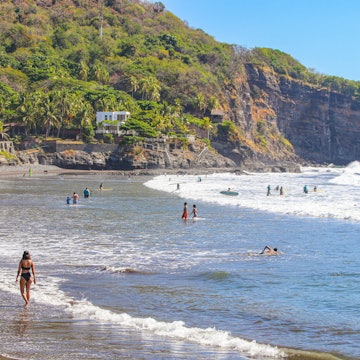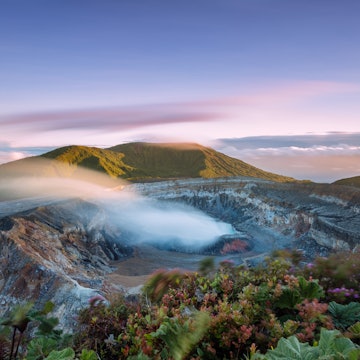
When is the best time to visit El Salvador?



The black-sand beach at El Zonte in El Salvador. Hugo Brizard - YouGoPhoto/Shutterstock
Travelers flock to Central America, crowding the Mayan ruins and golden Caribbean beaches of Mexico, Guatemala, Belize and Costa Rica, but little El Salvador often gets overlooked. You can partly blame the Spanish, who dismissed this corner of the isthmus as a backwater due to the lack of a Caribbean-facing coast.
El Salvador’s 1979–1992 civil war and problems with violent gangs didn’t make things any easier for the tourist industry, but there’s a tangible feeling that the country has turned a corner. Security is improving, crime is falling, and the government is investing in tourism infrastructure. And as for those Caribbean beaches, who needs them when you have the magnificent surf beaches of the Pacific Coast?
But when should you travel to El Salvador to get the best from its spectacular surfing, towering volcanoes, cozy small towns and culture-filled cities? Discover more with this seasonal guide to the best times to visit El Salvador.

November to April is the best time for surfing, beaches and soaking up the sun
Weather in El Salvador in the dry season: The dry season in El Salvador lives up to its name, with mostly dry days and clear skies, and temperatures hovering around 31°C on the coast, though it can be cooler in the highlands, particularly at night.
The surfing is spectacular all year round on the Pacific Coast of El Salvador, but the dry season (November to April) has the most consistent swells, the cleanest waves, and the sunniest skies, making this time of year ideal for surfers. Temperatures are perfect for getting in the water too, with daytime highs hitting 30°C even in December.
Top spots for beginners and intermediate surfers include El Tunco, about 40km south of San Salvador, and the nearby surf hubs of La Libertad and El Zonte. With the right swell, the right-hand point breaks along this section of coast can produce some of the best waves in Central America (the choppier rainy-season months from May to October produce the most powerful waves, but these take skill to master).
The coastline south and east of San Miguel also shines in the dry season. Head to Punta Mango, Playa El Cuco and secluded Playa Las Flores to catch the best wave action. November to April is also the best time to enjoy the golden sands of the Área Natural Protegida Complejo Los Cóbanos, accessible from the resort town of Los Cóbanos.
There are some big events on the cultural calendar, too. In November, the city of San Miguel pulls out all the stops for its annual Carnaval – a riot of colorful costumes, merengue dancing, drinking and Mardi Gras-style floats. Salvadorans celebrate Christmas on the evening of December 24, but huge crowds hit the beach on Christmas Day, and colorful lights and nativity scenes pop up everywhere.
New Year’s Eve is best celebrated in the bigger cities or in beachside traveler hangouts such as El Tunco. The sleepy town of Juayúa on the Ruta de las Flores explodes with fireworks, floats and street food in early January for the Fiestas de Cristo Negro celebrations, honoring the town’s patron saint, while the town of Suchitoto celebrates its artistic heritage with live weekend performances every February.
Communities all over the country host vibrant celebrations for Semana Santa (Holy Week) in the run up to Easter. Religious processions fill the streets, which are decorated with intricate patterns known as alfombras, made from colored sawdust. San Salvador, San Miguel and Santa Ana are all good places to celebrate.

November to April is also a great time for climbing volcanoes
The towering volcanoes that dot the Salvadoran landscape call out to hikers, and the dry season is the best time to ascend these dramatic summits. The authorities monitor volcanic activity to keep hikers safe, and the trails are dry, which makes for more pleasant walking. Hikers make a beeline for Volcán de San Salvador near San Salvador, accessed via the walking trails snaking through Parque Nacional El Boquerón, which sprawls around an 800-year-old crater.
The other key destination for volcano climbers is Parque Nacional Los Volcanes (also known as Parque Nacional Cerro Verde) to the south of Santa Ana, dominated by the mighty volcanic cones of Santa Ana (2381m), Izalco (1958m) and Cerro Verde (2030m). All three can be summited by hikers, but the level of difficulty varies; with kids in tow, stick to the easy trails up Cerro Verde.

May to October is the time for rain, cheaper prices and some big festivals
The weather in El Salvador in the rainy season: The rainy season arrives in May, bringing heavy showers and occasional thunderstorms. On the plus side, temperatures remain warm, and it doesn't rain all day, every day. As the rain mainly falls in the afternoon and evening, you may still be able to enjoy some sunny mornings.
As this is the low season for tourism, prices for flights and accommodations fall, and visitor numbers thin out at the sights. Surfers aren’t put off by the rain – some of the most impressive waves hit surfing hubs such as El Tunco, La Libertad and Punta Mango at this time of year.
There’s some great festival action. On August 31, residents of the town of Nejapa, to the north of San Salvador, commemorate the volcanic eruption that devastated the town in 1658 by throwing flaming balls made from kerosene-soaked rags and dancing till dawn around street bonfires for Bolas de Fuego.
In the same month, San Salvador hosts Fiestas Agostinas, honoring Jesus as the “Divine Savior of the World.” The city center fills up with floats, marching bands and parades in traditional Salvadoran costume. On September 15, people across the nation celebrate El Salvador's escape from Spanish rule with gusto for Dia de Independencia.

The best season for nature depends on the wildlife you want to see
El Salvador is alive with tropical wildlife and verdant natural scenery, but the best time to get out into nature varies depending on what you are hoping to see. The Ruta de Las Flores is at its most floral from April to May, when the coffee plantations lining the route are decorated with white coffee flowers. The dry months are also good times to explore the cloud forests of national parks such as Parque Nacional Los Volcanes and Parque Nacional Montecristo.
From November to March, divers and snorkelers can enjoy excellent visibility on the largest Pacific coral reef system in Central America, which is protected by the 264-sq-km Área Natural Protegida Complejo Los Cóbanos at the western end of the Costa de Bálsamo. This is also the time for whale-spotting trips to observe humpback whales on their annual Pacific migration.

Sea turtles arrive between July and December to lay their eggs in nesting areas along El Salvador's Pacific coastline. Olive ridley turtles favor the sandy beaches around La Libertad, while rare hawksbill turtles nest in the Bahía de Jiquilisco. At beaches around La Libertad, visitors can participate in baby turtle releases to help vulnerable hatchlings evade predators on their way to the water.
Birdlife flourishes in El Salvador all year round. The Bahía de Jiquilisco is thronged by migratory sea birds from September to April – October and November are the peak months for spotters. Species seen here range from pelicans and egrets to roseate spoonbills and magnificent frigate birds.
Head to the slopes of Cerro Verde in Parque Nacional Los Volcanes when the trails are dry from November to April to see colorful Central American forest birds such as cinnamon-bellied flowerpiercers, mockingbirds, hummingbirds, and turquoise-browed motmots.
This article was adapted from Lonely Planet’s Central America guidebook, published in October 2025.













